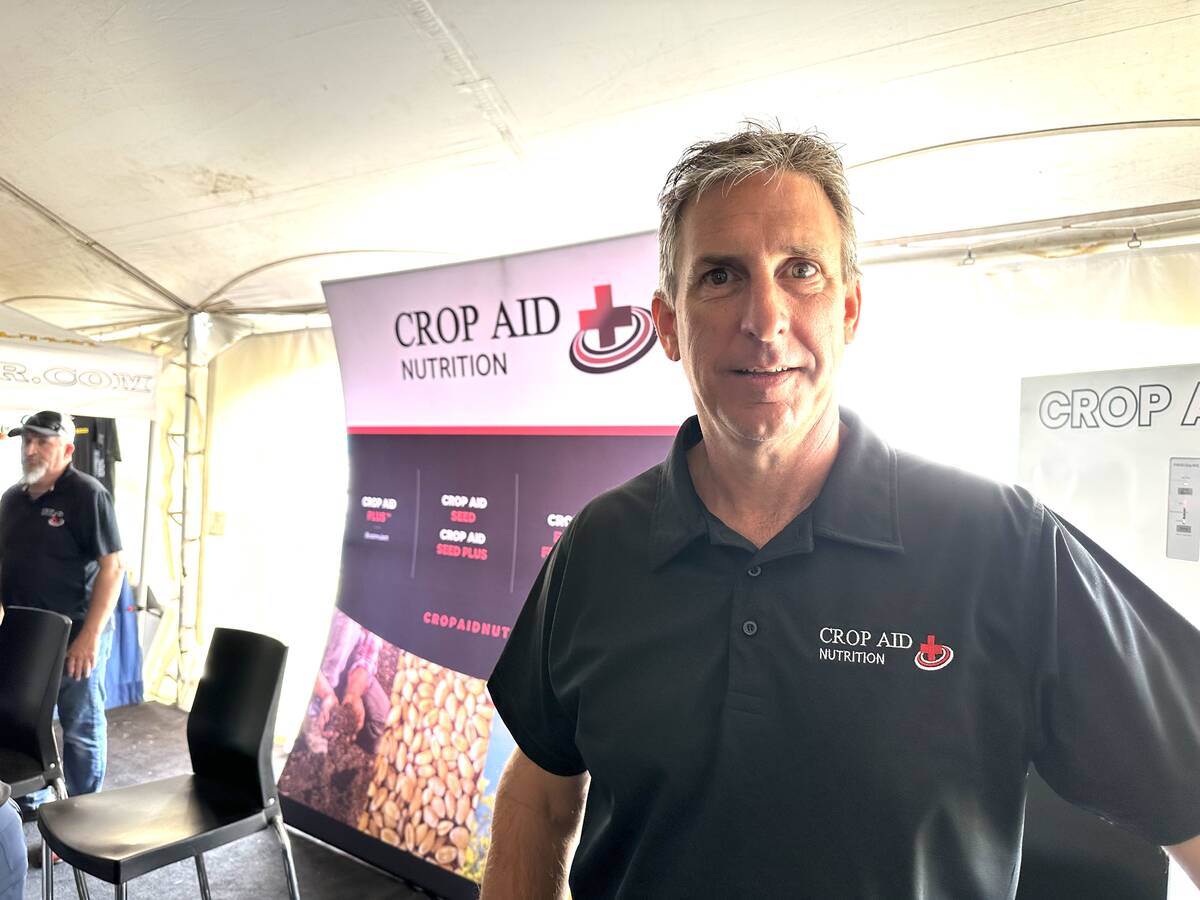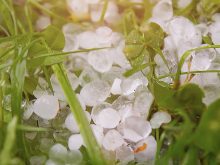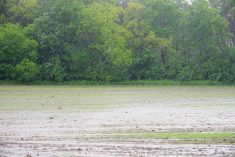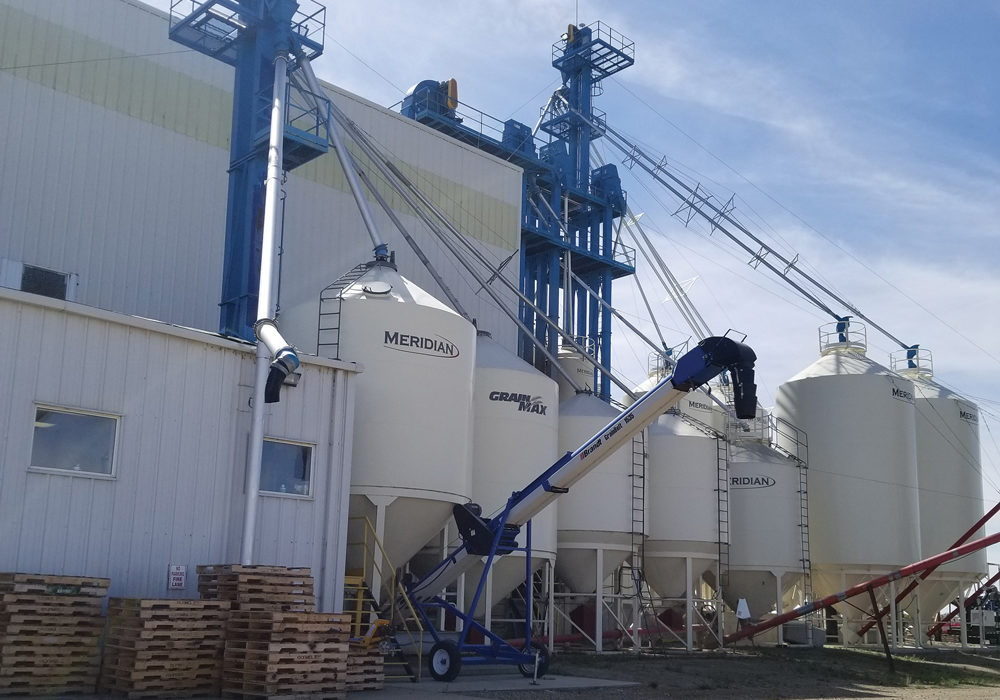We’re used to dealing with private sector hail insurance companies, or at least seeing their ads. Now two companies, both based in Moose Jaw, Sask., are offering private crop insurance products to cover grain farmers’ risk.
You might wonder how private companies could compete against a government-run Crop Insurance program where premiums are government subsidized to the tune of 50 per cent (at low yield coverage rates). Or why farmers would buy private insurance when there are already two different subsidized government programs available. But these companies are offering products that are just a little different than traditional Crop Insurance or AgriStability, and they might be a fit for your farm.
Read Also

New soil treatment targets saline patches in fields
Crop Aid SS is a Saskatchewan-made spray that’s intended to help farmers manage saline soils by leaching salts away from the root zone.
Global Ag Risk Solutions
Global Ag Risk Solutions is not exactly new. 2018 will be the eighth year the company has offered private production cost insurance. President/CEO Grant Kozior says GARS is now covering more than two million acres across the prairies.
GARS was developed by insurance experts working with an accountant from MNP, looking for a way to help farmers manage the higher risks that come along with increasing input costs.
Over the past decade, Kozior says, prairie grain farmers’ variable costs “have doubled, on average.” As well, he says, “fixed costs have gone up about 80 per cent.” With higher costs, there is more risk than ever at the farm level. Crop Insurance can help, but there are times when insurance payouts wouldn’t cover all of a farm’s input costs. AgriStability covers farm margins, but calculations can be complicated and payouts are based on historical reference margins.
GARS insures your input costs (seed, fertilizer and chemicals), plus an additional per-acre amount to put towards your fixed costs.
Here’s an example: you buy a plan to cover $150 per acre of direct input costs plus $125/ac. to put towards fixed costs. Now you have coverage of $275/ac. If you farm 10,000 acres, you’re insured for $2,750,000.
In mid-summer, say you decide to apply extra fungicide and fertilizer, raising your input costs by an additional $25/ac. Now you’re covered for $300/ac., for a total of $3,000,000. If your sales from crops grown this season are less than $3,000,000, you’ll be eligible for a payment.
There are lots of details.
- Your revenue, as calculated by GARS, is based on your actual yields and your actual sale prices.
- If you still have grain in the bin by May 1, your sales revenue will be calculated based on average prices in your area.
- You’ll need to enroll your whole farm. You can’t just pick one or two crops.
- Money spent in the fall (for example fall-applied fertilizer) is included in your input cost calculation.
- Once you have a policy in place, you may increase your input costs by up to 140 per cent of your previous three-year average spend without authorization from GARS. (For example, if you want to add more nitrogen during the growing season.)
- If you spend money to hedge your crop price, your hedging costs will be insured. If you contract at a high price and then can’t deliver due to low yields, your contract shortfall costs will also be covered.
As a GARS customer, you’re going to be working pretty closely with your advisor. Your advisor will know everything about your business and how it’s run.
To qualify, you’ll need to provide five years of full accrual financial statements and have your accountant send over a margin analysis along with notes about your inventory and operations. Once they have your information, your advisor will send over a quote, and you’ll decide if you want to purchase the product. While GARS doesn’t accept all applicants Kozior says the rejection rate is less than one per cent.
If sharing this much information to get a price quote makes you uncomfortable, Kozior says, consider the fact that you already give all of this information to your banker. “And,” he says, “if you really screw up, he takes your land.” Kozior thinks that farmers are more comfortable sharing information with bankers and accountants simply because we’re used to doing business that way.
Changing your attitude
When we talk to our clients, Kozior says, “we don’t talk about insurance, we talk about farming.”
Kozior believes farmers insured with GARS spend more on crop inputs. If there is any doubt whether or not to spray a fungicide, he says, GARS customers will go ahead and do it. Why wouldn’t you? If spending additional money on inputs leads to a bigger, more profitable crop, you’ll get the financial benefit. If the year turns dry and the yields aren’t there, your GARS payment should cover the cost of the additional input costs.
This, says Kozior, lets his customers “farm for a home run every year.” GARS advisors are likely to encourage their clients to try things like taking plant tissue tests during the growing season to see if top-dressing nitrogen could be a profitable option.
From 2011 to 2015, Kozior says, GARS customers spent, on average $139.74/ac. on input costs. Non-GARS customers, that is, farmers who applied for a GARS contract and were given a quote but chose not to purchase insurance, spent $125.66/ac. during that same period. Based on this data, GARS-insured farmers spent $14.09/ac. more than their counterparts. (Keep in mind, these numbers don’t include data from farmers who have never applied for a GARS contract.)
Having input costs insured, he says, “fundamentally changes a farmer’s behaviour,” and allows GARS clients to take more risk.
Kozior is not the only one saying that farmers using GARS insurance are spending more on inputs. Bayer has recognized that GARS customers are buying more inputs. They’re offering GARS clients a four per cent rebate on Bayer products (over and above the regular Bayer rebate).
Kozior says these extra expenditures have resulted in higher farm revenues. According to his data, that extra $14.09/ac. expenditure is returning an additional $34.97/ac. in higher revenues for his clients. Of course these customers had to spend, on average, $12/ac. to pay for the GARS premium.
However, Crop Insurance premiums, Kozior points out, would have been $9/ac. for these same farmers. “We’re $3 more than what they would have spent anyway,” he says.
Grant Kozior is very excited about the GARS product. “This is the first new idea in crop insurance since the early 1980s,” he says. He hopes that this product can be a “north star” for farmers, changing mindsets and enabling farmers to do all they can to maximize their yields every year, rather than focusing on financial survival.
GARS versus AgriStability
GARS and AgriStability are similar. Both hope to help farmers cover their margins (revenues less costs). Both programs are based on actual farm expenditures and revenues.
However, there are some key differences.
- AgriStability covers you based on your historic margins, while GARS covers you based on your input costs for the current year.
- GARS is sold by advisors who work closely with you and your numbers. Policies can be tailored to specific individual situations. AgriStability is more generic and generally involves little contact with program staff.
- During a series of years with declining profitability, your AgriStability coverage margin will decrease.
- GARS can pick and choose its customer and vary premium rates to reflect the actual risk levels of each farm. AgriStability accepts all applicants and has a set premium rate.
Just Solutions Agriculture
Just Solutions Agriculture is offering a completely different form of revenue insurance. You may not have heard of this product yet, as there’s been little advertising. Justin Simpkins, Just Solutions’ senior risk manager, says this is intentional as they get their product off the ground. “We work on referral sales,” he says.
As with GARS, Just Solutions’ advisors are closely involved with their customers. “We can work with them to help identify some of the risks,” Simpkins says.
Simpkins says Just Solutions identified the need for this product because, “the number one need on every farm is cash flow.” Just Solutions’ business interruption insurance, called Ag|Right Risk Management (ARRM), is intended to help farmers make sure they have enough cash to meet needs when things go wrong.
Instead of insuring your farm’s entire revenue, ARRM insures a specific “band” of your revenue.
Let’s look at an example. At seeding, a farmer growing canola, lentils and durum is expecting total sales revenue of $548/ac. Just Solutions covers that farmer for a “band” of $285 to $385/ac. — that is, total coverage of $100/ac. If the farmer winds up with $400/ac. revenue, there is no payment as he’s over the top of the $385/ac. band. If the farmer has a net revenue of $300/ac., the payout would be $85/ac. (the $385/ac. insured rate less $300/ac. actual revenue). If there’s a disaster and the farmer only brings in $50/ac., the maximum ARRM payment would be $100/ac. (the full band of $385/ac. less $285/ac.).
As always, there are details:
- Your advisor will work closely with you to help you estimate your expected revenue based on your data, your history, your area and the current commodity price index.
- Your actual sale prices are not used to calculate claims. Instead, your yields (adjusted for grade differentials) are multiplied by a public commodity price index based on November prices. This means, the AARM brochure says, “A client does not have to wait until his crops are sold, since the actual crop revenues are irrelevant to his claim.”
- Some clients buy Crop Insurance as well as ARRM insurance, to cover the risk of very low yields, when revenues may be well below the lower end of the insured band.
For the 2017 crop year, Simpkins says, “we’ll pay out a large number of claims.” Rather than sounding disturbed, he says “we’re excited about that. It’s become proof of concept.”
Simpkins is optimistic about the future of AARM, pointing out that they have a lot of capacity in the area of reinsurance (insurance for the insurance company). “We have five major reinsurers in 2017 who have a combined $60B in cash assets,” he says.
How can I choose?
Although these two new products are completely different, they add a lot of extra complexity to farmers’ insurance choices.
MNP has come to the rescue with a tool they call the Ag Risk Management Projector.
Steve Funk, MNP’s director, farm income programs, says, “That tool allows us to evaluate for a particular farm, and a particular year, the different opportunities in AgriStability, Crop Insurance, Global Ag Risk Solutions and Just Solutions Ag|Right Risk Management.”
To get a detailed analysis of how these four products would work for your farm, first, you would need to go to Just Solutions and GARS to get premium quotes. You would also need your Crop Insurance premium numbers and information about your AgriStability margin.
Then, Funk says, “We can program those into the calculator.” Your MNP advisor will ask you what you’re planning to seed, how many aces of each crop, and what you expect for commodity prices.
“That would form the basis for what their expected revenue is,” Funk says.
They’ll also ask what you plan to spend on inputs (seed, fertilizer, herbicide, fungicide), and then consider your estimates or your past financial statements to fill in the rest of your expenses.
“We’re trying to model a complete income statement including things like depreciation, interest, rent and even management salaries.”
With this information, your MNP advisor will show you a graph, starting with the most likely scenario based on what you expect for prices and production. Then, they’ll model further options with lower prices or lower production. “We’ll shave 10 per cent increments off,” Funk says.
“We can toggle on and off different options in terms of AgriStability, GARS, Ag|Right Risk Management and Crop Insurance and show how those products could potentially fill in some of those losses.”
They’ll show you side-by-side comparisons of price declines and production losses. “Programs react quite differently,” Funk says, depending on what goes wrong.
Once they start showing you personalized graphs, Funk says, “these different products all fit slightly different bands.” In some cases, he says, farmers will find overlap between two products. “In that case they don’t need both.”
The MNP computer simulation includes details for all four insurance program and lets your advisor show you 11 different revenue scenarios for the coming year. “There’s a lot of math that goes into these calculations,” Funk says. ”I don’t know how farmers do it without something like this.”
If you’re not an MNP client, you can still meet with them to use the Ag Risk Management Projector. “We find for the most part that producers have a pretty good idea of what they want to grow and what they expect from it, and what the basic direct input costs are. Even if we haven’t been preparing their statements for years we can look at the statements that they have from previous accountants they’ve dealt with, and use those to help estimate the rest of the cost.”
For a farm of 2,500 acres, the basic fee to use this calculator would be $1,200. Costs will increase with the size and complexity of your farm.
The future of private insurance
“Four or five years ago,” Funk says,“ I don’t think we would have said there’s a place for private sector insurance. It was hard to fathom how private sector insurance could compete with something that’s government subsidized.”
“I think that as time goes on the private sector companies are finding their niche. I think it’s unrealistic to expect that they’re going to compete across the same spectrum as subsidized government products like AgriStability and Crop Insurance. All the programs have different parameters and operate quite differently.”
It wouldn’t make sense for a company to compete head-to-head with the government-subsidized Crop Insurance program, Funk says. “They have to come in with a different product that has different parameters, and that will operate in a certain niche or in a certain band.”















